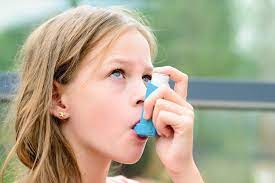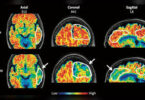F.P. Report
ISLAMABAD: Viral respiratory infections are the most common cause of asthma attacks, but nonviral factors such as air pollutants are also associated with the flare-up of asthma symptoms.
A recent study published in the journal Lancet Planetary Health reports that higher air pollution levels, particularly ozone and fine particulate matter concentrations, were associated with asthma attacks and a decline in lung function in children living in urban centers.
Researchers also noted that these air pollutants could trigger asthma attacks even when their concentrations were below national air quality standards.
The researchers added that higher ozone and fine particulate matter concentrations were associated with the activation of specific inflammatory pathways in the airways, helping to understand how higher pollutant levels may lead to an increased risk of asthma attacks in children living in urban areas.
“I think that this paper is very interesting and important because they were able not only to look at asthma exacerbation but also had data on the absence of respiratory virus and examined other outcomes,” said Dr. Antonella Zanobetti, an environmental health researcher at Harvard T.H. Chan School of Public Health in Boston.
“They show an association between air pollution and asthma exacerbations occurring in the absence of a provoking respiratory virus; therefore, air pollution in this study was a trigger of asthma exacerbations independently of respiratory viral infections, which in turn is important to understand the biological mechanisms,” he told Medical News Today.
“Their study went much further than many other studies in that they carefully analyzed the relationship between air pollution and asthma exacerbations regardless of whether these events occurred during viral infections or not,” added Dr. Allen Dozor, a professor of pediatrics and division chief of Pulmonology at New York Medical College.
“Viral infections are very common in children and most severe asthma events are associated with upper respiratory tract infections (URIs) or colds,” he told Medical News Today. “Children catch an amazing number of colds each year, but for many children, particularly in areas with high levels of air pollution, colds frequently lead to severe asthma attacks. It is important to emphasize that high levels of air pollution worsen both viral-associated and non-viral-associated asthma attacks.”
Asthma attacks: What to know
Asthma is a chronic condition characterized by the inflammation and narrowing of the bronchiTrusted Source, the main airways in the lungs, and its branches.
The symptoms of asthma include chest tightness, breathlessness, coughing, and wheezing that tend to worsen during an asthma exacerbation.
An asthma exacerbation, also known as an asthma attack, involves a further narrowing of the lung airways due to the inflammation of the cells of the airways and the contraction of bronchial muscles. This is accompanied by the production of excess mucus that also leads to the obstruction of airways.
Respiratory tract viral infections are one of the most common causes of asthma exacerbation in both children and adults. However, an asthma exacerbation can also occur due to non-viral causes, such as non-viral infections, allergens, pollen, and pet hair.
In addition, several epidemiological studies have shown a linkTrusted Source between air pollutant levels and the occurrence of asthma attacks. Higher levels of several air pollutants, such as fine particulate matter, ozone, nitrogen dioxide, and sulfur dioxide, have been linked to the occurrence of asthma attacks.
Asthma is one of the most common chronic conditions in children. Moreover, studies suggest that children residing in low socioeconomic and urban neighborhoods show higher asthma morbidity and prevalence. Higher air pollution levels are characteristic of these neighborhoods and may explain the greater prevalence and severity of asthma in children living in low-income urban areas.
However, the molecular mechanisms underlying asthma exacerbation during non-viral respiratory illnesses, especially in vulnerable populations such as children with severe asthma, are not well understood. In addition, the differences in the mechanisms that underlie asthma exacerbations caused due to air pollutants and viral infections have not been characterized.
Impact of air pollutants on asthma
In the new study, the researchers initially examined the association between air pollutant levels and asthma exacerbation in children and adolescents residing in urban neighborhoods.
The researchers analyzed data from a previous observational study titled “Mechanisms Underlying Asthma Exacerbations Prevented and Persistent with Immune-based Therapy Part 1 (MUPPITS1).”
That study’s authors had previously used data from MUPPITS1 to examine the molecular mechanisms underlying viral and non-viral asthma exacerbations.
The aim of the new study was to use the MUPPITS1 data to specifically understand the molecular basis of non-viral asthma exacerbations caused due to air pollutants.
MUPPITS1 included 208 children aged 6 to 17 years with exacerbation-prone asthma residing in low-income neighborhoods in nine United States cities. The study collected data on lung function and nasal samples from these participants after the onset of symptoms of an episode of respiratory illness.
The researchers used the nasal samples to determine whether the respiratory illness was caused due to a viral infection or due to non-viral factors. They also further classified participants on the basis of whether they did or did not have an asthma exacerbation during the illness.
The researchers then used data on the Air Quality Index and the concentrations of individual pollutants collected by the Environmental Protection Agency (EPA) for each geographical area included in the study. These air pollution data were matched with each participant’s location and date of illness.
The researchers reported that the Air Quality Index values were higher nine days before and after the onset of symptoms in participants with a non-viral asthma exacerbation than those with a viral asthma exacerbation. In addition, the Air Quality Index values were negatively correlated with lung function in the participants with non-viral asthma exacerbations.
A similar association between Air Quality Index and non-viral asthma exacerbations was also observed using data from a different study involving 419 individuals aged between 6 to 20 years residing in low-income households in eight major US cities.
Data from both studies showed that ozone and fine particulate matter (PM2.5) concentrations were higher during episodes of non-viral asthma exacerbation. Moreover, ozone concentrations were associated with a decline in lung function.
The Air Quality Index values and ozone concentrations did not exceed the national air quality standards. The fine particulate matter concentrations only exceeded the standard ambient values in some instances.
The study authors said that this could suggest that exposure to low levels of air pollutants over multiple days could be adequate to cause an asthma attack. They also noted that the regional EPA values might not capture high levels of these pollutants in specific urban localities.
Moreover, personal exposure to air pollutants may vary even for individuals residing in the same location. (Online)







